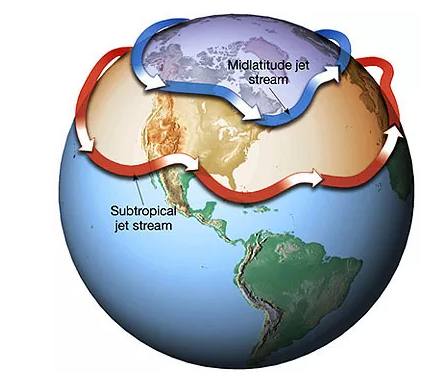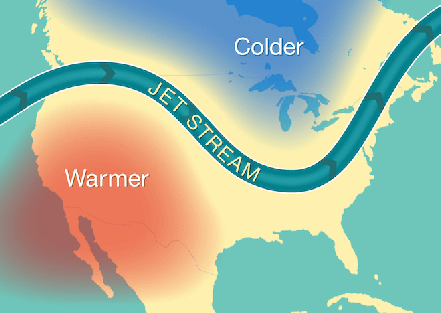Jet stream is a high-altitude air current that flows from west to east. It is found in the middle and upper levels of the Earth’s atmosphere. The stream has a profound effect on the weather and climate, as well as on commercial aviation.
Table of Contents
What is Jet Stream?
A jet stream is a fast-flowing, narrow band of air that is found at high altitudes in the Earth’s atmosphere. These streams of air move from west to east and can reach speeds of over 200 mph. Jet streams are found at altitudes between 30,000 and 40,000 feet. They are an important factor in determining the weather patterns and climate of the regions.

How Jet Streams are formed?
While reading the below explanation, please assume that you are living in the Northern hemisphere.
Step I: Solar Heating
The radiation from Sun heats the Earth surface. This heating is not uniform across the globe. The equatorial regions receive more direct sunlight and therefore are warmer, whereas the polar regions receive less direct sunlight and are colder. This temperature difference between the equator and the poles creates a temperature gradient in the atmosphere.

Step II: Formation of Polar Front
The temperature gradient created in step I leads to the formation of a boundary called the polar front. At the polar front, the warm air masses from south meet cold air masses from the north. This creates a zone of temperature contrast.
"The jet stream is strongest in winter when the temperature difference between the polar and equatorial regions is greatest."

Step III: Formation of Upper-Level Winds
As warm air rises and cold air sinks along the polar front, the upper-level winds are generated. The Coriolis force starts working on this moving wind. Due to this Coriolis force, winds to be deflected to the right in the Northern Hemisphere and to the left in the Southern Hemisphere. This deflection results in the formation of a fast-flowing river of air at high altitudes, known as the jet stream.
Step IV: Meandering Wind
The combination of the temperature gradient and Coriolis effect results in the formation of a meandering, high-speed current of air in the upper troposphere. We call it the Jet Stream.
Characteristics of Jet Stream
Speed and Direction
Jet streams flow from west to east at speeds of over 200 mph. The speed depends of the season, topography and other climatic factors.
Altitude
Jet streams are found at high altitudes between 30,000 and 40,000 feet above sea level. This high altitude makes them difficult to observe directly, but they can be detected using weather radar and satellites.
Seasonal Variations
The strength and location of jet streams can vary depending on the season. During the winter months, the jet stream is stronger and located further south, while in the summer it is weaker and located further north.
Types of Jet Stream
There are two main types of jet stream.
- Polar Jet Stream
- Subtropical Jet stream
Polar Jet Stream
Formation
The polar jet stream is formed by the temperature contrast between the cold air over the poles and the warmer air at lower latitudes. The polar jet stream typically forms at latitudes between 50° and 60° north and south.
Characteristics
The polar jet stream is characterized by its strong west-to-east winds and its meandering path. The polar jet stream can have a profound effect on weather patterns, as it helps to steer weather systems across the Earth’s surface. During the winter months, the polar jet stream can bring cold Arctic air to lower latitudes, while in the summer it can bring warm, moist air from the tropics.
Importance
The polar jet stream is of critical importance to the Earth’s weather patterns, as it helps to transport heat and moisture from one region to another. This helps to balance the temperature and precipitation patterns across the Earth’s surface and can play a role in mitigating extreme weather events.
"Jet Stream can stretch for thousands of miles across the globe."
Subtropical Jet Stream
Formation
The subtropical jet stream is formed by the temperature contrast between the warm air over the subtropics and the colder air at higher latitudes. The subtropical jet stream typically forms at latitudes between 20° and 30° north and south.
Characteristics
The subtropical jet stream is characterized by its strong west-to-east winds and its relatively stable path. Unlike the polar jet stream, the subtropical jet stream does not meander significantly, and its position is relatively fixed.
Importance
The subtropical jet stream plays an important role in transporting moisture from the subtropics to higher latitudes. This can help to influence precipitation patterns and can play a role in mitigating extreme weather events.
"Climate change is affecting the jet stream, causing it to become more erratic and unpredictable."
Jet Stream and Weather Patterns
Relationship between Jet Stream and Weather Systems:
The jet stream can have a significant impact on weather patterns, as it helps to steer and influence the development of weather systems. For example, a strong jet stream can steer a weather system quickly across a region, while a weak jet stream can allow a weather system to linger and bring extended periods of rain or snow.
Role in Determining Weather
The position and strength of the jet stream can play a critical role in determining the weather patterns in a given region. For example, if the jet stream is located further south, it can bring cold Arctic air to lower latitudes, while if it is located further north, it can bring warm, moist air from the tropics. The speed of the jet stream can also play a role, as a strong jet stream can quickly steer weather systems across a region, while a weak jet stream can allow a weather system to linger.
Influence of Jet Stream on Extreme Weather
The jet stream can play a significant role in extreme weather events, such as hurricanes, droughts, and heat waves. For example, a strong jet stream can steer a hurricane away from a coastal region, while a weak jet stream can allow a hurricane to linger and bring extended periods of heavy rainfall. Similarly, a strong jet stream can bring relief from a heat wave, while a weak jet stream can allow a heat wave to persist.
Jet Stream and Commercial Aviation
How Jet Stream Affects Air Travel
The jet stream can have a significant impact on commercial aviation, as airplanes fly at high altitudes to take advantage of the strong tailwinds that can be found in the jet stream. This can help to reduce fuel consumption and travel time, making air travel more efficient and cost-effective.
Importance of Understanding Jet Stream for Pilots
For pilots, understanding the jet stream is critical, as it can help to optimize flight routes and improve safety. Pilots must take into account the speed and direction of the jet stream when planning a flight, as it can have a major impact on flight time and fuel consumption. For example, flying into a strong headwind can significantly slow down a flight, while flying with a strong tailwind can significantly speed it up.